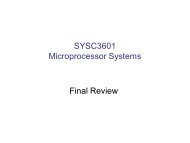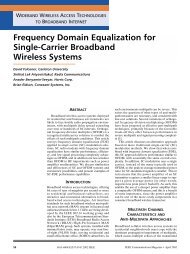Image Reconstruction for 3D Lung Imaging - Department of Systems ...
Image Reconstruction for 3D Lung Imaging - Department of Systems ...
Image Reconstruction for 3D Lung Imaging - Department of Systems ...
Create successful ePaper yourself
Turn your PDF publications into a flip-book with our unique Google optimized e-Paper software.
variability <strong>of</strong> image energy as a function <strong>of</strong> target height. The Rdiag and RLap priors<br />
provide the largest image energy but are also the most variable with respect to target vertical<br />
position. For example targets located in one <strong>of</strong> the electrode planes result in reconstructions<br />
with four times as much energy as the same target located at the extreme ends <strong>of</strong> the tank.<br />
Figure 5.8(f) shows the signal to noise ratio <strong>of</strong> the reconstructed images.<br />
Overall the Rdiag prior gives the best results however the difference between it and the<br />
RLap prior is minor. No work was completed <strong>for</strong> this paper concerning the effect <strong>of</strong> electrode<br />
plane separation on reconstruction per<strong>for</strong>mance.<br />
5.3.4 Human <strong>Lung</strong> Data Results<br />
The basic analysis <strong>of</strong> sections 5.3.1 and 5.3.3 are based on impulse contrasts which are not<br />
necessarily representative <strong>of</strong> complex contrasts. In order to test the Nodal Jacobian Inverse<br />
Solver <strong>for</strong> complex contrasts we reconstructed some lab data <strong>of</strong> human lungs using the Rdiag<br />
prior. Data were measured from a human subject using the equipment and <strong>3D</strong> protocol<br />
<strong>of</strong> section 5.2.1. The reconstruction shown in figure 5.9 was calculated in 12s on an AMD<br />
Athlon 64 3000+ with 2GB RAM using 45 iterations <strong>of</strong> Matlab’s built-in preconditioned<br />
conjugate gradient function. The image on the left <strong>of</strong> figure 5.9 shows vertical planes <strong>of</strong><br />
the <strong>3D</strong> volume. The images on the right <strong>of</strong> figure 5.9 are two horizontal slices <strong>of</strong> the <strong>3D</strong><br />
reconstruction model. The lungs are readily observed in the two horizontal slices. The<br />
vertical slice on the left shows that the vertical extent <strong>of</strong> the lungs does not extend to the<br />
vertical extremes <strong>of</strong> the <strong>3D</strong> modeled volume. These results suggest that the Nodal Jacobian<br />
algorithm can be used <strong>for</strong> clinical applications.<br />
Figure 5.9: Human <strong>Lung</strong> Data reconstructed using Nodal Jacobian Algorithm with the Rdiag<br />
prior.<br />
5.4 Discussion<br />
This paper has presented a new family <strong>of</strong> algorithms <strong>for</strong> solving the inverse problem in<br />
EIT. The main advantage <strong>of</strong> the Nodal Jacobian algorithm is that it reduces the size <strong>of</strong><br />
the linear system that must be solved. This allows the reconstruction <strong>of</strong> images from <strong>3D</strong><br />
75





